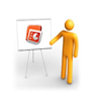Arguably the most easily available programme for making visual presentations for both e-mail communication and conference display screens with relative ease is Microsoft's PowerPoint. Unfortunately, the very ease of its availability has resulted in an overwhelmingly large proportion of unimaginative and drab "presentations" in both academic and professional areas. Perhaps more than 90% of presenters seem to use PowerPoint as an electronic whiteboard, displaying dozens of slides, with hundreds of words written in sentence form. As a result, too many viewers spend hours copying down word for word from the screen, physically exhausting themselves in the process and unable to give sufficient attention to what the presenter is actually saying.
This is a colossal and tragic waste of a resource that has so much potential to add significant value to an oral presentation. It also reflects that the presenter is not aware of this potential and has not put in enough creativity into preparing a first-class, stimulating and lucid presentation.
 |
Komark's focus is NOT on "PowerPoint commands". That can be taught by any software specialist. Our emphasis is on how to use this rich resource intelligently and effectively. While the learner is taught several commands and also given an inititation into the use of colour and colour theory, the programme is not a comprehensive explanation of PowerPoint or of graphics in general.
- 1. Graphics – where to find them, how to use them
- 2. Animation – the need to keep the presentation dynamic
- 3. Graphics or words – how to balance them
- 4. Colours – their influence on mood and tone
- 5. Numbers– translating them to images
- 6. Statistics – bringing numbers to life
- 7. Editing– controlling pace and message
- 8. You- you're the star, PowerPoint is your slave
Like everything else at Komark, the entire programme is highly practical in nature: the learner is required to work step by step on presentations of increasing complexity.

